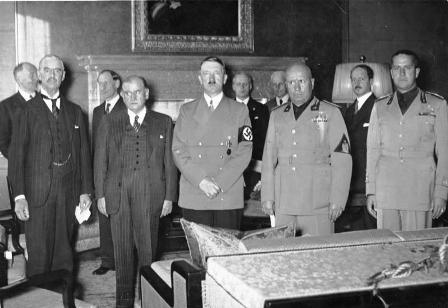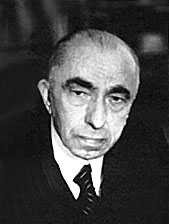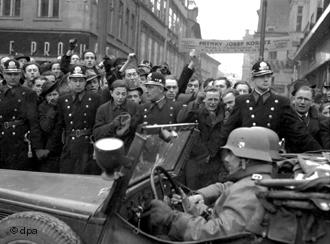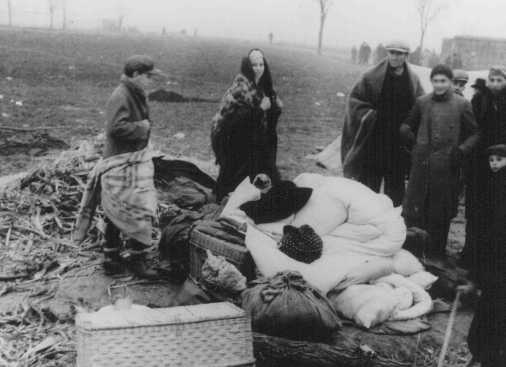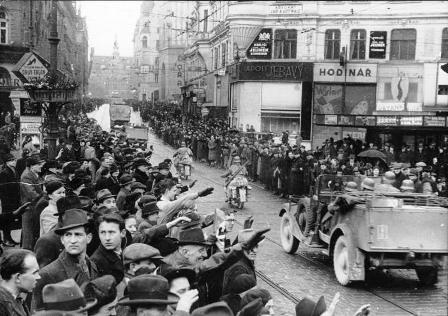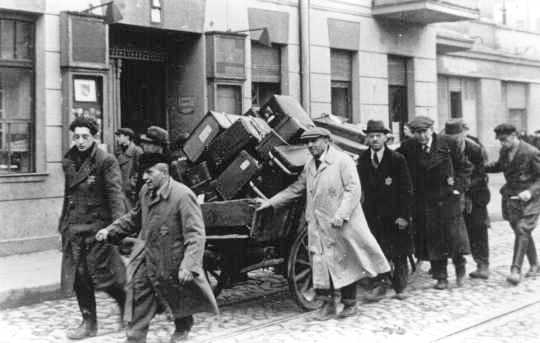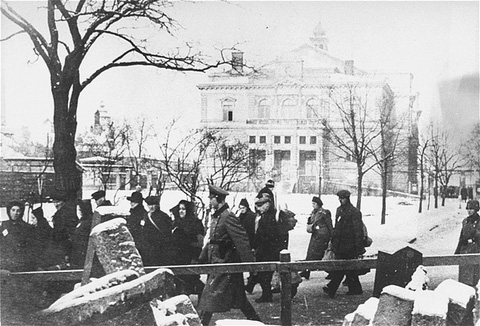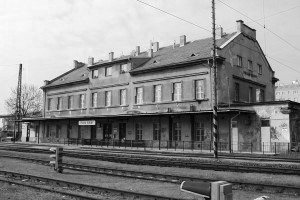Holocaust Education & Archive Research Team |
|
Occupat Occupation German Occupation of Europe Timeline
-
[The Occupied Nations]
Poland Austria Belgium Bulgaria Denmark France Germany Greece Hungary Italy Luxembourg The Netherlands Norway Romania Slovakia Soviet Union Sudetenland | ||||||
The Jews of the Sudetenland Bohemia & Moravia
The Sudetenland is the German name used in the first half of the 20th century for the western portions of Czechoslovakia inhabited mostly by ethnic Germans. Located on the border with Germany and Austria it encompasses the areas of Bohemia, Moravia, and those parts of Silesia associated with Bohemia.
When Czechoslovakia was forced to accept the terms of the Munich Agreement on Sept 29th 1938, the region was relegated to German control between October 1 and October 10, 1938. The remaining parts of Czechoslovakia were subsequently invaded by Germany in March 1939, with a portion being annexed and the remainder turned into a satellite state, the Protectorate of Bohemia and Moravia.
Administration of the Protectorate was placed under the supervision of the Reichsprotektor, Konstantin von Neurath and shortly there after Hitler summoned Czechoslovak President Emil Hácha to Berlin and intimidated him into accepting the German occupation of the Czech rump state.
Four days after the occupation, a huge German military parade was held on Wenceslas Square. A live report from a popular Czechoslovak Radio host Franta Kocourek from the balcony of the Hotel Sroubek described the confusion amongst the Czech populace at the time:
Hácha remained as technical head of state with the title of State President; German officials manned departments analogous to cabinet ministries, while small German control offices were established locally.
The population of the protectorate was mobilized for labour that would aid the German war effort, and special offices were organized to supervise the management of industries important to that effort.
Czechs were drafted to work in coal mines, the iron and steel industry, and armaments production; some young people were sent to Germany. Consumer goods production were largely directed toward supplying the German armed forces. The government and political system, reorganized by Hácha, continued in formal existence. Gestapo activities were directed mainly against Czech politicians and the intelligentsia.
At the close of 1938 elections in the Reichsgau Sudetenland. Polls showed that 97.32% of the adult population voted for NSDAP. Close to a half million ethnic Germans joined the Nazi Party roughly 17.34% of the entire German population in region, making the Sudetenland the most "pro-Nazi" region in the Third Reich.
On the eve of the German occupation, 118,310 Jews lived in the region, centralized mostly in Prague. Immediately after the occupation, a wave of arrests began, mostly of refugees from Germany, Czech public figures, and Jews. Fascist organizations began harassing Jews: synagogues were burnt down and Jews were rounded up and attacked in the streets. As early as November 3, 1938, the immediate expulsion of Czechs and Jews from the region became a daily occurrence and groups of Czech nationals were forced from the Sudetenland towards the Czech frontier. Some of these managed to escape to Prague or Brno, but all Jews were turned back by the Czech boarder guards.
On November 8, 1938, the Czechoslovak government took steps to prevent Jewish refugees from establishing themselves in Bohemia by barring their participation in all forms of commerce and liberal professions.
By January 1939 Nazi administrators contacted Jewish families, inquiring about their nationality and the language spoken at home. Several families received questionnaires via the mail with an extensive array of questions regarding race, religion, nationality and associations.
During the first years of the Protectorate the German occupation authorities attempted to reduce the number of Jews as radically as possible by deportation. In June Adolf Eichmann arrived in Prague to establish the Central Office for Jewish Emigration (Zentralstelle Fuer Juedische Auswanderung), with his own special methods to encourage the Jews to leave the country.
A system was established for this purpose; a policy of discriminatory measures designed to force Jewish emigration at a price. An exit Visa came only after payment of an exorbitant fee and one's remaining property was compulsorily transferred to German banks in charge of trustees.
At the same time as Eichmann's arrival, a decree was issued barring Jews in the protectorate from almost all economic activity, and much Jewish property was seized. Jewish businesses were "bought" by Germans using force and threats. In all, the Germans seized about a half-billion dollars worth of Jewish property in the Protectorate of Bohemia and Moravia.
Despite the extortionist tax and loss of property some 26,629 Jews managed to emigrate, legally or not, before emigration was completely banned in October 1941.
The Jews of Moravska Ostrava were the first on Czech territory to feel it. On October 18 and 27, 1939, two Jewish transports left with 1292 men for the railway station Nisko on the river San in the eastern part of Lublin in occupied Poland. These transports were included in a drive to cleanse the Katowitz region of its Jews.
Between October and November five deportation trains with each 1,000 persons on board went from Prague to Lodz, and a further transport brought 1,000 persons from Brno to Minsk, about 200 Austrian Jews among them.
However the "Nisko campaign" concluded before the first transports from Katowice, Ostrava, and Vienna ever reached Nisko. On October 17 Hitler reset the priorities, and the new German districts in the Wartheland and West Prussia were created in Poland in the areas directly annexed to the Reich.
These new Germanized regions were to be the first districts cleared of their Jews. However in the Protectorate, Jews were still managing to flee by crossing the border into Poland, and Slovakia. An estimated 30,00 Jews are believed to have left the territory of the Protectorate at this time only to be caught up in the Final Solution to be implemented later in throughout Poland, Slovakia, and Hungary.
By the end of 1939, according to official statistics, 19 016 Jewish emigrants had left the Protectorate and in 1940 yet another 6 176 Jewish emigrants. In the following two years the figure had dropped to 817.
On 27 September 1941 Heydrich was appointed Stellvertretender Reichsprotektor in the Protectorate of Bohemia and Moravia and assumed effective government of the territory, as Hitler felt Konstantin von Neurath, Heydrich's predecessor, wasn't draconian enough. Heydrich came to Prague to restore proper order.
Between October and December 1941, German authorities deported around 42,000 Jews from the so-called Greater German Reich -- including Austria and the annexed Czech lands of Bohemia and Moravia -- virtually all to ghettos in Lodz, Minsk, Kovno, and Riga.
Heydrich regularly wrote reports on his Prague activities to the Chief of the NSDAP Party office, Martin Bormann, assuming that they were being passed on to Hitler. His Report dated October 11 contained his updates on the Jewish problem in the Protectorate:
"At present 88 000 Jews live in the Protectorate, of which there are 48 000 in Prague, 10 000 in Brno, 10 000 in Moravska Ostrava and the rest spread over the whole of the Protectorate. In order to evacuate them, these Jews will be concentrated during the coming weeks at one place still to be designated; this will be some kind of evacuation camp and the men will be allocated to forced labor. The first 5 000 Jews will be evacuated to the east after October 15, via Litzmannstadt. " German Jews sent to Lodz in 1941 and to Warsaw, the Izbica and Piaski transit ghettos and other locations in the Generalgouvernement in the first half of 1942 numbered among those deported together with Polish Jews to the killing centers of Chelmno, Treblinka, and Belzec.
In Lodz the fate of some of the Sudetenland Jews was documented by the locals:
"Thursday 4 December 1941
Yesterday at 7.00pm, 21 year old Piotr Schultz who had come to the ghetto in the fourth transport from Prague and was a resident of 29 Franciszkanska Street was shot to death by a sentry near the barbed wire at the intersection of Stefan and Legiewnicka streets.
The victim, a worker, who was born in Cieplice (Teplice) in the Sudetenland. Schultz had volunteered for the transport in Prague, so as not to be separated from his fiancée, a sixteen year old woman, who had been sent to the ghetto here, in the second transport.
He had given no sign of having any suicidal inclinations. Schultz had applied for work in the saddlery located on the outskirts of the ghetto, in the former Balut slaughterhouse.
On the critical evening he had spent a long time walking about in the vicinity of the slaughterhouse, evidently waiting for someone in connection with his efforts to find employment.
Not familiar with the terrain there, he had approached the barbed wire too closely a few times. As usual Stefan Street was completely deserted when the shooting occurred and thus there were no eyewitnesses to the incident.
The German criminal police were informed of the shooting, and after performing an investigation at the scene, they ordered the body taken to the mortuary at Hospital No.1. "
Terezin (Theresienstadt):
The fortress of Terezín was constructed between the years 1780 and 1790 by the orders of the Austrian emperor Joseph II in the north-west region of Bohemia. On June 10, 1940, the Gestapo took control of Terezín and set up a prison system for political prisoners. Heydrich believed the fortress would serve perfectly as the evacuation camp for Jews and held a meeting in Prague on October 10.
He plane to organize two separate ghettos, one in Bohemia and the other in Moravia. One of them as a labor camp, the other as a provisioning camp. The prisoners were to produce small goods and straw mats made by hand for military units in the field, to be collected by the appointed Judenrat officials to be exchanged for the bare minimum of food.
Between 1941 and late 1944, the German authorities, assisted by local Czech gendarmerie, deported 73,603 Jews from Prague, Brno, Ostrava, Olomouc, and other towns of the Protectorate to Terezin. Statistics from the months between April and September 1942 show the consistence increase in the number of prisoners: April (12,968) May (14,300) June (21,269) July (43,403) August (51,554) September (53,264) Some Jews her imprisoned for long period of time in Terezin but most were kept only briefly as SS and police personnel deported the vast majority to killing sites in the Baltic States and transit camp-ghettos in District Lublin in occupied Poland in 1941-1942 and, from 1942 on, to the Auschwitz killing center.
According to official statistics, in the period from March 15, 1939 to March 15, 1945, 8 210 Jews died in the Protectorate (not including those killed in Terezin). During the same period only 637 Jewish children were born
Of nearly 141,184 Jews to reside in Terezin, the Germans deported 88,202 to the east, where most of them were killed. 33,456 died in Terezin itself. 2,418 either escaped or were released by the Germans in 1945. The Germans and their collaborators killed approximately 263,000 Jews who had resided on the territory of the Czechoslovak Republic in 1938.
Sources:
Die Sudetendeutschen im NS-Staat. Politik und Stimmung der Bevölkerung im Reichsgau Sudetenland (1938-1945).Zimmermann, Volker The Chronicle of the Lodz Ghetto edited by Lucjan Dobroszycki, published by Yale University Press 1984 The Jews of Bohemia and Moravia By Livia Rothkirchen Czech National Archives Milady Horákové 133, Praha 6 - Dejvice US National Archives- College Park USHMM
Copyright Carmelo Lisciotto & Chris Webb H.E.A.R.T 2009
|
